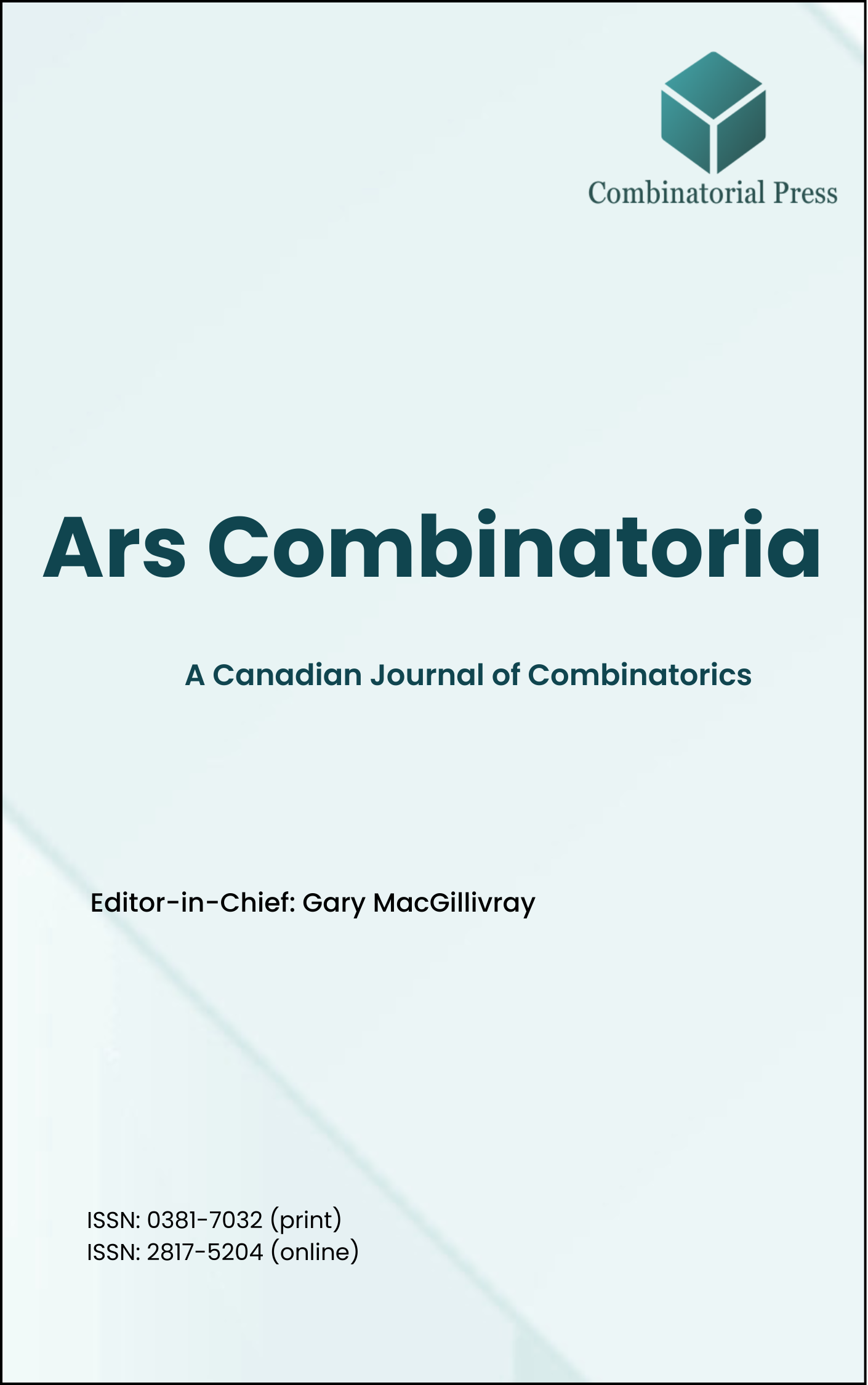
Ars Combinatoria
ISSN 0381-7032 (print), 2817-5204 (online)
Ars Combinatoria is the oldest Canadian Journal of Combinatorics, established in 1976. The journal is dedicated to advancing the field of combinatorial mathematics through the publication of high-quality research papers. From 2024 onward, it publishes four volumes per year in March, June, September and December. Ars Combinatoria has gained recognition and visibility in the academic community and is indexed in renowned databases such as MathSciNet, Zentralblatt, and Scopus. The Scope of the journal includes Graph theory, Design theory, Extremal combinatorics, Enumeration, Algebraic combinatorics, Combinatorial optimization, Ramsey theory, Automorphism groups, Coding theory, Finite geometries, Chemical graph theory but not limited.
Information Menu
- Research article
- https://doi.org/10.61091/ars161-01
- Full Text
- Ars Combinatoria
- Volume 161
- Pages: 3-16
- Published: 31/12/2024
Let \( G \) be a graph, the zero forcing number \( Z(G) \) is the minimum of \( |Z| \) over all zero forcing sets \( Z \subseteq V(G) \). In this paper, we are interested in studying the zero forcing number of quartic circulant graphs \( C_{p}\left(s,t\right) \), where \( p \) is an odd prime. Based on the fact that \( C_{p}\left(s,t\right) \cong C_{p}\left(1,q\right) \), we give the exact values of the zero forcing number of some specific quartic circulant graphs.
- Research article
- https://doi.org/10.61091/ars-160-17
- Full Text
- Ars Combinatoria
- Volume 160
- Pages: 211-229
- Published: 30/09/2024
Behera and Panda defined a balancing number as a number b for which the sum of the numbers from \(1\) to \(b – 1\) is equal to the sum of the numbers from \(b + 1\) to \(b + r\) for some r. They also classified all such numbers. We define two notions of balancing numbers for Farey fractions and enumerate all possible solutions. In the stricter definition, there is exactly one solution, whereas in the weaker one all sufficiently large numbers work. We also define notions of balancing numbers for levers and mobiles, then show that these variants have many acceptable arrangements. For an arbitrary mobile, we prove that we can place disjoint consecutive sequences at each of the leaves and still have the mobile balance. However, if we impose certain additional restrictions, then it is impossible to balance a mobile.
- Research article
- https://doi.org/10.61091/ars-160-16
- Full Text
- Ars Combinatoria
- Volume 160
- Pages: 205-209
- Published: 30/09/2024
The secure edge dominating set of a graph \( G \) is an edge dominating set \( F \) with the property that for each edge \( e \in E-F \), there exists \( f \in F \) adjacent to \( e \) such that \( (F-\{f\})\cup \{e\} \) is an edge dominating set. In this paper, we obtained upper bounds for edge domination and secure edge domination number for Mycielski of a tree.
- Research article
- https://doi.org/10.61091/ars-160-15
- Full Text
- Ars Combinatoria
- Volume 160
- Pages: 195-203
- Published: 30/09/2024
In this paper we contribute to the literature of computational chemistry by providing exact expressions for the detour index of joins of Hamilton-connected (\(HC\)) graphs. This improves upon existing results by loosening the requirement of a molecular graph being Hamilton-connected and only requirement certain subgraphs to be Hamilton-connected.
- Research article
- https://doi.org/10.61091/ars-160-14
- Full Text
- Ars Combinatoria
- Volume 160
- Pages: 161-193
- Published: 30/09/2024
The geometrical properties of a plane determine the tilings that can be built on it. Because of the negative curvature of the hyperbolic plane, we may find several types of groups of symmetries in patterns built on such a surface, which implies the existence of an infinitude of possible tiling families. Using generating functions, we count the vertices of a uniform tiling from any fixed vertex. We count vertices for all families of valence \(5\) and for general vertices with valence \(6\), with even-sized faces. We also give some general results about the behavior of the vertices and edges of the tilings under consideration.
- Research article
- https://doi.org/10.61091/ars-160-13
- Full Text
- Ars Combinatoria
- Volume 160
- Pages: 141-159
- Published: 30/09/2024
This study extends the concept of competition graphs to cubic fuzzy competition graphs by introducing additional variations including cubic fuzzy out-neighbourhoods, cubic fuzzy in-neighbourhoods, open neighbourhood cubic fuzzy graphs, closed neighbourhood cubic fuzzy graphs, cubic fuzzy (k) neighbourhood graphs and cubic fuzzy [k]-neighbourhood graphs. These variations provide further insights into the relationships and competition within the graph structure, each with its own defined characteristics and examples. These cubic fuzzy CMGs are further classified as cubic fuzzy k-competition graphs that show competition in the \(k\)th order between components, \(p\)-competition cubic fuzzy graphs that concentrate on competition in terms of membership degrees, and \(m\)-step cubic fuzzy competition graphs that analyze competition in terms of steps. Further, some related results about independent strong vertices and edges have been obtained for these cubic fuzzy competition graph classes. Finally, the proposed concept of cubic fuzzy competition graphs is supported by a numerical example. This example showcases how the framework of cubic fuzzy competition graphs can be practically applied to the predator-prey model to illustrate the representation and analysis of ambiguous information within the graph structures.
- Research article
- https://doi.org/10.61091/ars-160-12
- Full Text
- Ars Combinatoria
- Volume 160
- Pages: 127-139
- Published: 30/09/2024
A graph \( X \) is \( k \)-spanning cyclable if for any subset \( S \) of \( k \) distinct vertices there is a 2-factor of \( X \) consisting of \( k \) cycles such that each vertex in \( S \) belongs to a distinct cycle. In this paper, we examine the \( k \)-spanning cyclability of 4-valent Cayley graphs on Abelian groups.
- Research article
- https://doi.org/10.61091/ars-160-11
- Full Text
- Ars Combinatoria
- Volume 160
- Pages: 117-126
- Published: 30/09/2024
A path \(x_1, x_2, \dots, x_n\) in a connected graph \( G \) that has no edge \( x_i x_j \) \((j \geq i+3)\) is called a monophonic-triangular path or mt-path. A non-empty subset \( M \) of \( V(G) \) is a monophonic-triangular set or mt-set of \( G \) if every member in \( V(G) \) exists in a mt-path joining some pair of members in \( M \). The monophonic-triangular number or mt-number is the lowest cardinality of an mt-set of \( G \) and it is symbolized by \( mt(G) \). The general properties satisfied by mt-sets are discussed. Also, we establish \( mt \)-number boundaries and discover similar results for a few common graphs. Graphs \( G \) of order \( p \) with \( mt(G) = p \), \( p – 1 \), or \( p – 2 \) are characterized.
- Research article
- https://doi.org/10.61091/ars-160-10
- Full Text
- Ars Combinatoria
- Volume 160
- Pages: 105-115
- Published: 30/09/2024
This note presents a counterexample to Propositions 7 and 8 in the paper [1], where the authors determine the values of \( V \) and \( W \). These values are crucial in determining the Hamming distance and MDS codes in the family of certain constacyclic codes over \(\mathbb{F}_{p^m}[u]/\langle u^3 \rangle\), which implies that the results found in [2] are incorrect. Furthermore, we provide corrections to the aforementioned results.
- Research article
- https://doi.org/10.61091/ars-160-09
- Full Text
- Ars Combinatoria
- Volume 160
- Pages: 85-103
- Published: 30/09/2024
For a graph \( G \) and for non-negative integers \( p, q \) and \( r \), the triplet \( (p, q, r) \) is said to be an admissible triplet, if \( 3p + 4q + 6r = |E(G)| \). If \( G \) admits a decomposition into \( p \) cycles of length \( 3 \), \( q \) cycles of length \( 4 \), and \( r \) cycles of length \( 6 \) for every admissible triplet \( (p, q, r) \), then we say that \( G \) has a \( \{C_{3}^{p}, C_{4}^{q}, C_{6}^{r}\} \)-decomposition. In this paper, the necessary conditions for the existence of \( \{C_{3}^{p}, C_{4}^{q}, C_{6}^{r}\} \)-decomposition of \( K_{\ell, m, n}(\ell \leq m \leq n) \) are proved to be sufficient. This affirmatively answers the problem raised in \emph{Decomposing complete tripartite graphs into cycles of lengths \( 3 \) and \( 4 \), Discrete Math. 197/198 (1999), 123-135}. As a corollary, we deduce the main results of \emph{Decomposing complete tripartite graphs into cycles of lengths \( 3 \) and \( 4 \), Discrete Math., 197/198, 123-135 (1999)} and \emph{Decompositions of complete tripartite graphs into cycles of lengths \( 3 \) and \( 6 \), Austral. J. Combin., 73(1), 220-241 (2019)}.





